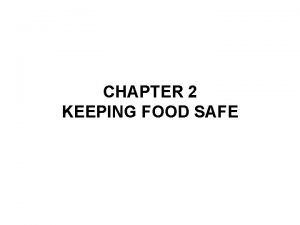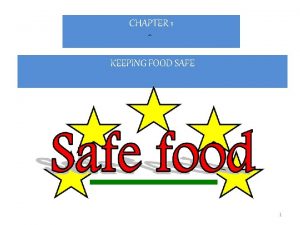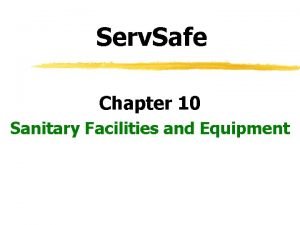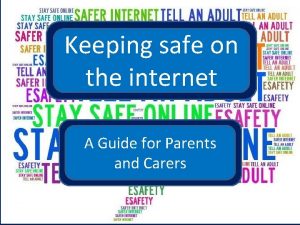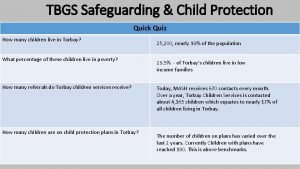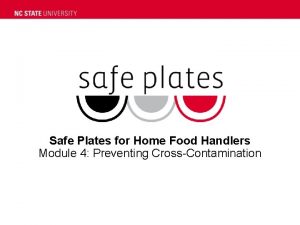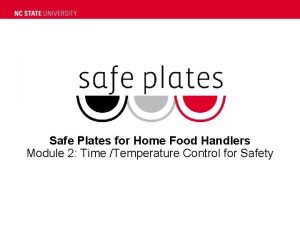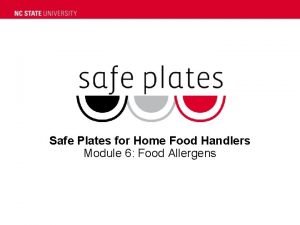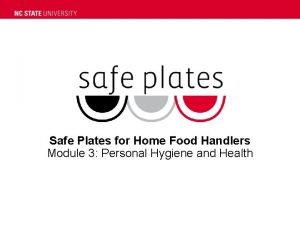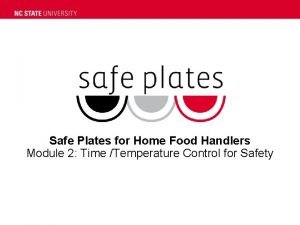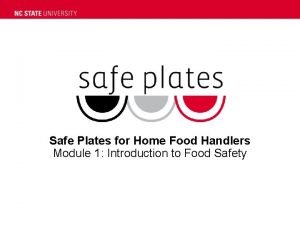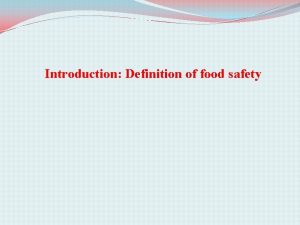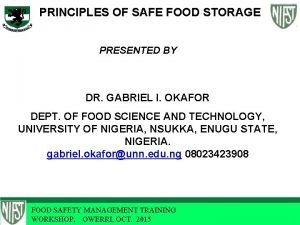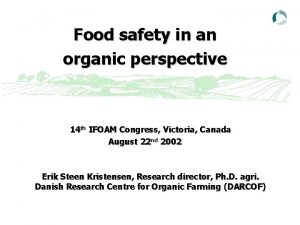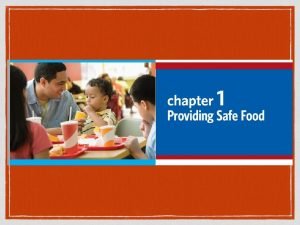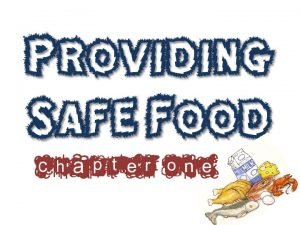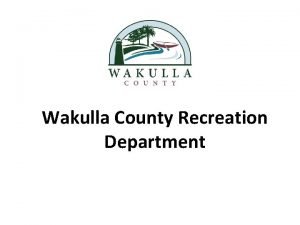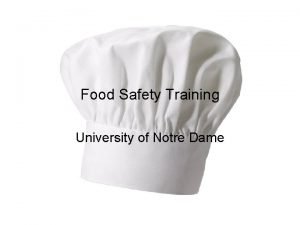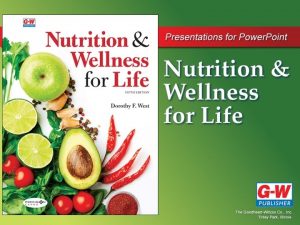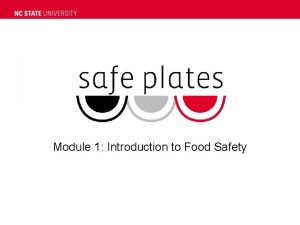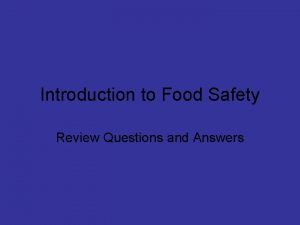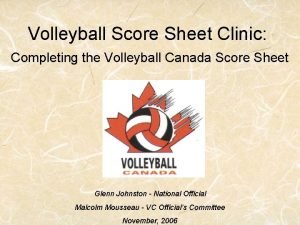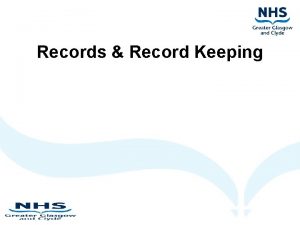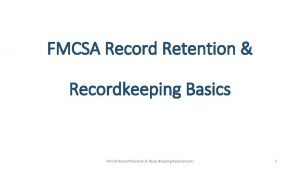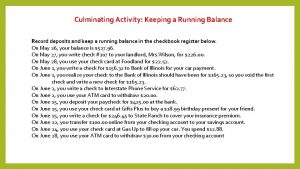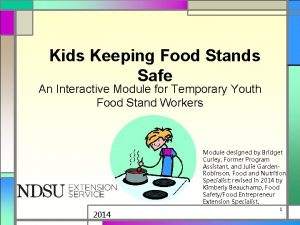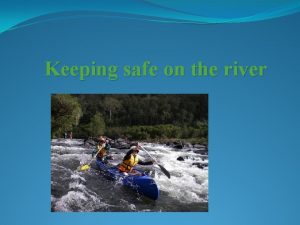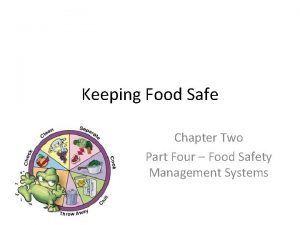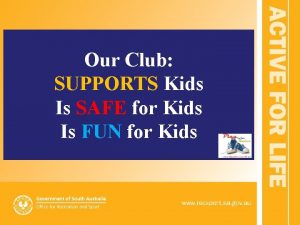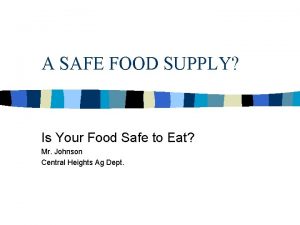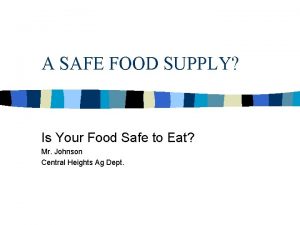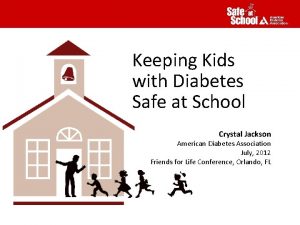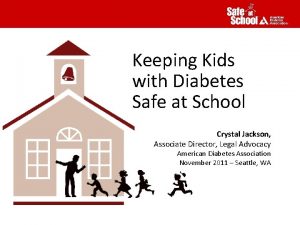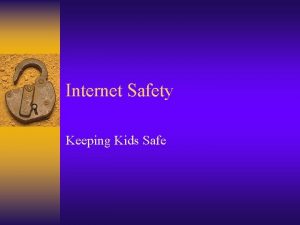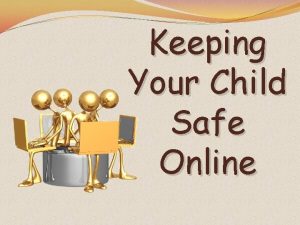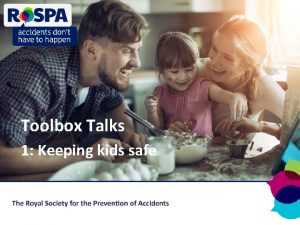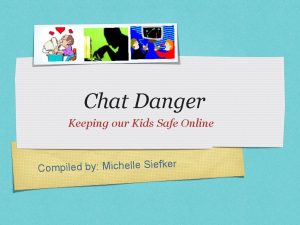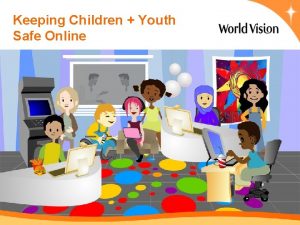Kids Keeping Food Stands Safe An Interactive Module













































- Slides: 45

Kids Keeping Food Stands Safe An Interactive Module for Temporary Youth Food Stand Workers Module designed by Bridget Curley, Former Program Assistant, and Julie Garden. Robinson, Food and Nutrition Specialist; revised in 2014 by Kimberly Beauchamp, Food Safety/Food Entrepreneur Extension Specialist. 2014 1

How to work though this program □ Click the left mouse button (or the down arrow )to go to the next bullet or slide. □ Before you go through the module, a new window will open, and you’ll answer some survey questions. □ When you are finished with the survey questions, close the window to return to the slides in this program module. 2

□ When you see this symbol , click your mouse once to see answer. □ When you see this symbol , “stop and think” of the answer. Then, click your mouse to see the answer. 3

□ Near the end of the module, you will take a second survey. □ The second survey will open in a new window. □ When you are finished with the survey, close the window to return to the program module. 4

It’s Time to Take the Pre. Survey □ Click here to begin the survey. □ You’ll return this module when you are done with the pre-survey. 5

Serving food to the public can be a fun experience □ Remember: □ Personal safety and food safety come first. □ Be careful when working, and keep a clean workplace. 6

Question Time □ Working at a temporary food stand should be: a) Fun b) Boring c) Unenjoyable □ Click to see answer The answer is a. We hope the experience is enjoyable for those who have the chance to help out. 7

Stay safe while working □ Do not lift heavy objects by yourself. Get help! □ Be extra careful when working with sharp objects, such as knives. □ Be careful around stoves and other hot equipment. □ Do not burn yourself. Handle hot foods carefully. □ Keep the floors clean and clear of objects so you don’t trip over anything. □ Clean up spills to avoid slipping. 8

□ Be careful when working with “potentially hazardous” foods. □ These are foods that may become contaminated if not stored or cooked properly. Examples of “potentially hazardous” foods: Sandwiches made with meat Fish Poultry Salads Meat Egg products Milk 9

You are responsible for identifying “potentially hazardous” foods. □ Click below to reveal the “potentially hazardous” foods. Potentially Hazardous 10

□ Keep your work area clean and free of germs □ A clean area helps reduce the risk of spreading “germs” such as bacteria, into food. □ Germs can contaminate the food. □ People can get very sick from eating contaminated food. 11

What are the Four Steps to Food Safety? CLEAN SEPARATE COOK CHILL □ When people get an illness from eating contaminated food, it is because something probably went wrong in one of these areas. 12

True or False □ The important food safety areas to remember are clean, separate, cook and chill. □ Click to see the answer 13

14

Cleaning and Sanitizing □ Keep work areas, equipment and dishes clean and sanitized. □ “Sanitized” means you have used a sanitizer such as a bleachwater rinse, after cleaning. □ Cleaning and sanitizing counters and dishes helps stop bacteria in their tracks! 15

□ Clean surfaces such as counters and tables by wiping them with paper towels and sanitizer solution. □ Homemade sanitizer solutions can be made by mixing 1 tablespoon of chlorine bleach with 1 gallon of water. □ Do not use sponges or cloth towels to clean up spills.

□ Inspect areas where food is prepared, eaten and served and identify areas that need to be cleaned □ Click to see three areas that need cleaning in this picture Dirt y 17

20 Seconds □ A Homemade sanitizer solution can be created from ______? a) 1 cup of water and 1 tablespoon of chlorine bleach. b) 1 gallon of water and 1 tablespoon of chlorine bleach ¨ Click to reveal answer c) 1 quart of water and 3 tablespoons of chlorine bleach. 18

Cleaning dishes Scrape off excess food before washing dishes #1) Wash dishes with warm, soapy water. #2) Rinse off the soap with hot water. #3) Next, rinse with the sanitizing solution. □ Sanitizing reduces the amount of germs on each item. □ Just because something looks clean does not mean it is sanitized or safe to use. #4) Allow dishes to air dry. □ Dishtowels can spread bacteria from dish to dish. 19

□ You have been assigned to help wash dishes. What is the correct order to clean dishes and utensils properly? □ Click and the correct order will appear. Sanitize Scrape Air dry Rinse Wash 20

Volunteer Health and Hygiene □ Wash your hands before starting work and many times during your shift. □ Wash hands in warm, soapy water for at least 20 seconds. □ Dry them using a paper towel and throw the towel in the garbage. 21

20 Seconds □ Is that a long time? How do you know when the 20 seconds are up? a) b) c) d) Sing “Twinkle, Little Star” Slowly count 20 Mississippis Hum the “ABC” song to yourself All are good ideas ¨ Click to reveal answer Using any of these ideas while washing your hands will help you wash them long enough to get them clean! 22

Always Wash Your Hands: □ … Before touching food or clean surfaces □ … After you touch food □ … If you touch your face, touch your eyes, touch your hair, blow your nose, or go to the bathroom □ … If you handle money □ Money is covered in germs. □ If you touch money while wearing gloves, wash your hands before touching food. □ … If you use your phone □ Cell phones are covered in germs. □ If you use your phone, wash your hands before touching food or clean surfaces. 23

Keep Neat and Clean! □ Before starting your shift, have a clean appearance and a clean apron to keep your clothes from becoming dirty. □ If you have long hair, tie it back (such as a ponytail, or braided) □ Wearing a hair restraint is a good idea so loose hairs do not get into anyone’s food. 24

You are about to start your shift. □ Which of the following should you do before starting? □ Click to reveal answer. Not Important 25

Glove Safety □ Everyone should wear disposable gloves when handling food. □ Be sure to put on new gloves, after washing your hands. □ Always change your gloves, if they become dirty or torn, or if you switch tasks. □ For example, if you are serving pizza and then switch to serving cookies, change your gloves to prevent cross contamination. 26

27

Contamination and Foodborne Illness □ Separate foods, to reduce the risk of transferring germs from one food to another. □ Foods can pick up germs if it touches a surface that has not been cleaned and sanitized properly. □ Never allow raw food to come in contact with cooked or ready-to-serve food. 28

Serving Utensil Use □ Before starting your shift, have the correct supplies available. □ Have serving utensils, such as tongs, ladles and scoops, ready so you minimize your food contact. □ Have enough utensils available for each different food. □ For example, you do not want to use the hot dog tongs to grab a cookie. 29

□ If you need to touch food, only do so wearing clean disposable gloves. □ When filling cup, plate and napkin dispensers, fill from the back or bottom so all products are used in the order you fill them. 30

Match the following foods with the proper serving utensils : 1. Hot dog 2. Mashed potatoes 3. Soup 4. Nacho chips d. Tongs a. Gloved hand b. Scoop c. Ladle c. Scoop b. Ladle d. Gloved a. Tongs hand □ Click and the correct answers will appear 31

32

Preparing, cooking and serving food □ Keep the temperature “danger zone” in mind. □ Danger Zone = Temperatures between 41 F and 140 F. □ At these temperatures, germs and bacteria can grow quickly. □ An adult should check foods with a thermometer frequently to ensure that temperatures are safe. 33

You noticed some of the equipment is not heating foods correctly. □ Pick out the foods in the temperature danger zone. □ Click to see the answer. Poultry should be heated to 165 F not 65 F 34

Serving Customers □ Food should be served to customers with disposable dishes, such as paper plates, Styrofoam cups and plastic silverware. □ When handing plates, cups or silverware to customers, never touch the part that will come in contact with food or the person’s mouth. □ If customers ask you to carry items for them, take only what you can handle. 35

You have to serve food to customers □ Click to reveal the portion of these objects that you should touch while passing food to customers. 36

Before You Start □ Ask for instructions, if you are uncertain of the area or the station you will be working in. □ Are you feeling unsure of the area? □ Are you feeling unfamiliar with the station? □ Do you feel a lack experience with the equipment? Ask an adult before starting. 37

38

Storing Food □ Store food in appropriate containers so the food is safe for later use. □ Use shallow containers to store food in refrigerator. □ Thick foods, such as sloppy joe meat or chili, should be chilled in a container no more than 2 inches deep. □ Other foods, such as a thin soup, can be stored 3 inches deep. 39

True or False □ The shallower the food level, the quicker it will chill to a safe temperature. □ Click to see the answer. 40

Label Containers □ Cover food with a lid or plastic wrap before putting it away. □ Label the container with the date, time and what is in it. □ This allows the next person to identify the contents without taking it out and uncovering it. □ Writing the date and time lets people know when the food was prepared and how long it is safe to use. 41

Which containers are labeled correctly? □ Click to see the answer. A. The date and contents are both listed B. 42

Ice Safety □ Food safety also applies to ice served in drinks. □ Remember, ice touches the liquids that customers will drink. □ Do not touch the ice with your hands, or scoop the ice with a cup. □ Use a metal scoop when adding ice to drinking cups or ice coolers. 43

Time to Take the Post-survey □ After completing all the activities and review questions, you are ready to take the survey! Good luck! □ Click here to begin post-survey! 44

Do you want to learn more? Visit www. ag. ndsu. edu/food-safety NDSU is an equal opportunity institution. 45
 Chapter 2 keeping food safe
Chapter 2 keeping food safe Potentially hazardous food is usually moist
Potentially hazardous food is usually moist Safe feed safe food
Safe feed safe food Keeping an infant safe and well section 7-3
Keeping an infant safe and well section 7-3 Keeping an infant safe and well section 7-3
Keeping an infant safe and well section 7-3 Servsafe chapter 10
Servsafe chapter 10 Keeping safe on the internet
Keeping safe on the internet Keeping children safe in education 2019
Keeping children safe in education 2019 Ted safeguarding
Ted safeguarding Kids r kids west cobb
Kids r kids west cobb Safe people safe places
Safe people safe places Servsafe module 4
Servsafe module 4 Safe plates module 2
Safe plates module 2 Module 6 food
Module 6 food Reinstated food handler
Reinstated food handler Safe plates module 1 answer key
Safe plates module 1 answer key Safe plates module 1
Safe plates module 1 Unit 2 food food food
Unit 2 food food food Food chain food chain food chain
Food chain food chain food chain Food web in cameroon
Food web in cameroon Food pyramid for kids
Food pyramid for kids Rich tudors food
Rich tudors food Food chain for kids
Food chain for kids C device module module 1
C device module module 1 Defination of food safety
Defination of food safety 5 principles of safe food storage
5 principles of safe food storage Danger zone temperature for food in celsius
Danger zone temperature for food in celsius Four steps to food safety
Four steps to food safety Definition of safe food
Definition of safe food Time-temperature abuse definition
Time-temperature abuse definition Tcs food
Tcs food Wakulla county parks and rec
Wakulla county parks and rec Food stands
Food stands Food stands
Food stands Module 1 introduction to food safety
Module 1 introduction to food safety Cross contamination examples
Cross contamination examples Volleyball alberta score keeping
Volleyball alberta score keeping Alliteration in keeping quiet
Alliteration in keeping quiet Hussain manawer poems
Hussain manawer poems Keeping your hands clean and dry persuasive essay
Keeping your hands clean and dry persuasive essay Legible meaning
Legible meaning Gap year jackie kay
Gap year jackie kay Jackie kay lucozade
Jackie kay lucozade Functions of the press
Functions of the press Fmcsa document retention
Fmcsa document retention Culminating activity keeping a running balance
Culminating activity keeping a running balance
